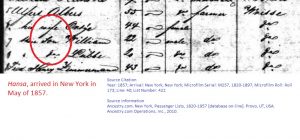 Sound genealogical practice tells researchers to always look at the original. The list of reasons is long and littered with specific examples, but it boils down to one thing:
Sound genealogical practice tells researchers to always look at the original. The list of reasons is long and littered with specific examples, but it boils down to one thing:
ya ain’t never know what ya gonna find til you look at it
This 1857 manifest of the Hansa, which arrived in New York City in May of that year is a prime example. The clerk who filled out the manifest should have been employed train every other clerk. Not only did he list the names, but he also listed the relationship. In some manifests one can conjecture these relationships, but it is nice to have them spelled out. Those details, since they are not typically listed on manifests during this era, are not included in the databases created from these records at sites such as Ancestry.com.
The word “transcription” was not used intentionally.
A transcription is a complete copying of a document, every word, every letter. The online indexes that we use are usually not transcriptions. They are extractions of key elements of the record for use in searching.
And you never know what is on the original unless you have looked at the original.

No responses yet